engine Alfa Romeo 156 2004 Owner handbook (in English)
[x] Cancel search | Manufacturer: ALFA ROMEO, Model Year: 2004, Model line: 156, Model: Alfa Romeo 156 2004Pages: 357, PDF Size: 5.04 MB
Page 138 of 357
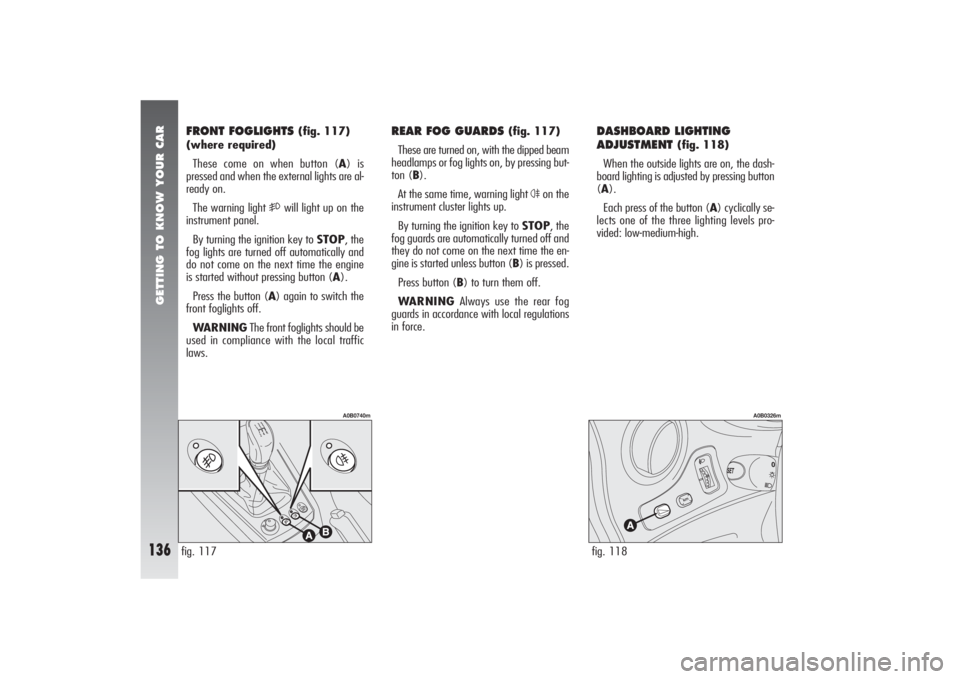
GETTING TO KNOW YOUR CAR
136
DASHBOARD LIGHTING
ADJUSTMENT
(fig. 118)
When the outside lights are on, the dash-
board lighting is adjusted by pressing button
(A).
Each press of the button (A) cyclically se-
lects one of the three lighting levels pro-
vided: low-medium-high.
FRONT FOGLIGHTS
(fig. 117)
(where required)
These come on when button (A) is
pressed and when the external lights are al-
ready on.
The warning light
5
will light up on the
instrument panel.
By turning the ignition key to STOP, the
fog lights are turned off automatically and
do not come on the next time the engine
is started without pressing button (A).
Press the button (A) again to switch the
front foglights off.
WARNINGThe front foglights should be
used in compliance with the local traffic
laws.
REAR FOG GUARDS
(fig. 117)
These are turned on, with the dipped beam
headlamps or fog lights on, by pressing but-
ton (B).
At the same time, warning light
4
on the
instrument cluster lights up.
By turning the ignition key to STOP, the
fog guards are automatically turned off and
they do not come on the next time the en-
gine is started unless button (B) is pressed.
Press button (B) to turn them off.
WARNINGAlways use the rear fog
guards in accordance with local regulations
in force.
fig. 117
A0B0740m
fig. 118
A0B0326m
Page 139 of 357

GETTING TO KNOW YOUR CAR
137
Inspect the care carefully to make sure that
there are no fuel leaks, for instance in the
engine compartment, under the vehicle or
near the tank area.
If no leaks are found and the vehicle can
be restarted again, press button (A) to ac-
tivate the fuel supply system.
After a collision, remember to turn the ig-
nition key to STOP so as not to run the bat-
tery down.
INERTIAL FUEL CUT-OFF
SWITCH
(fig. 119)
This is an automatic safety switch which is
triggered in the event of crash to interrupt
the flow of fuel.
The intervention of the inertial switch is in-
dicated by a message + symbol on the In-
focenter display (see “Infocenter Display”
in this chapter) and by the door unlocking.
fig. 119
A0B0574m
fig. 120
A0B0044m
OPENING THE FUEL FLAP(fig. 120)
The fuel flap is released from inside the car
raising the front part of the lever (A).
If a smell of fuel is noted
following an accident, or
the fuel system is leaking, to avoid
the risk of fire do not reset the
switch.
WARNING
Page 142 of 357

GETTING TO KNOW YOUR CAR
140
For 2.5 V6 24V versions and Diesel ver-
sions, to engage reverse gear (R), it is nec-
essary to wait for the car to be stationary,
then raise the ring under the grip (with the
fingers of the same hand holding the lever).
After engaging reverse gear, release the
ring. It is not necessary to raise the ring on
the lever when shifting from reverse to an-
other gear.WARNINGReverse gear can only be en-
gaged with the vehicle completely stopped.
With the engine running, before engaging
reverse gear it is necessary to wait for at
least 3 seconds with the clutch pedal fully
pressed, to avoid grating and the possibil-
ity of damaging the gears.Do not drive with your
hand resting on the
gearshift lever, since the
applied pressure, though slight,
may, with the passing of time,
damage parts inside the gear.
To change gear smoothly,
the clutch pedal must be
fully depressed. Therefore, there
should be no hindrances under the
pedal unit. Make sure that any
mats are well laid and do not in-
terfere with the pedals.
WARNING
Page 143 of 357
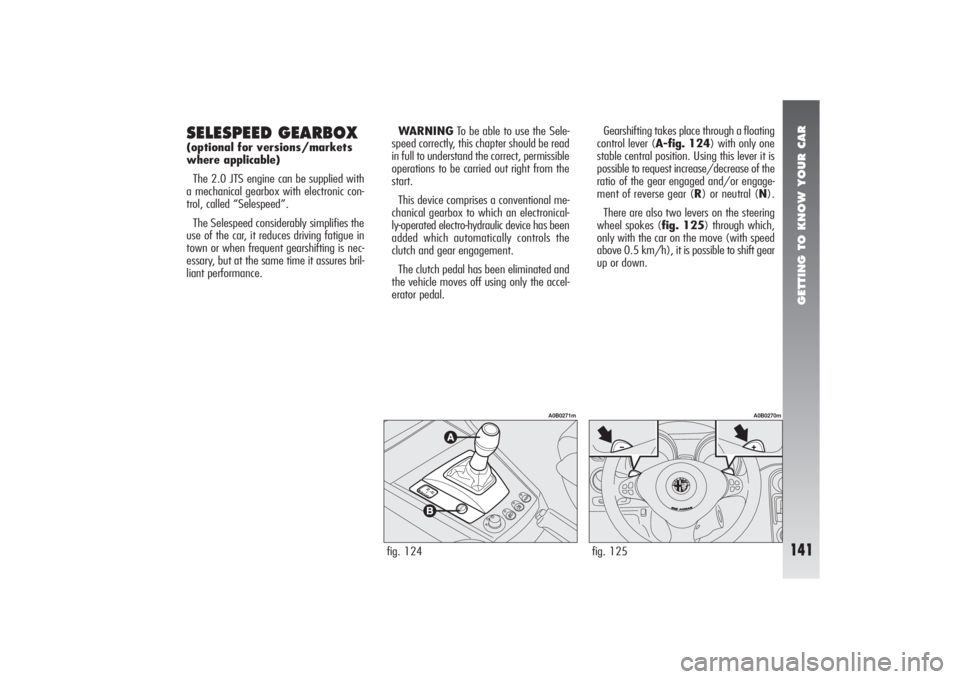
GETTING TO KNOW YOUR CAR
141
Gearshifting takes place through a floating
control lever (A-fig. 124) with only one
stable central position. Using this lever it is
possible to request increase/decrease of the
ratio of the gear engaged and/or engage-
ment of reverse gear (R) or neutral (N).
There are also two levers on the steering
wheel spokes (fig. 125) through which,
only with the car on the move (with speed
above 0.5 km/h), it is possible to shift gear
up or down.
SELESPEED GEARBOX (optional for versions/markets
where applicable)
The 2.0 JTS engine can be supplied with
a mechanical gearbox with electronic con-
trol, called “Selespeed”.
The Selespeed considerably simplifies the
use of the car, it reduces driving fatigue in
town or when frequent gearshifting is nec-
essary, but at the same time it assures bril-
liant performance.WARNINGTo be able to use the Sele-
speed correctly, this chapter should be read
in full to understand the correct, permissible
operations to be carried out right from the
start.
This device comprises a conventional me-
chanical gearbox to which an electronical-
ly-operated electro-hydraulic device has been
added which automatically controls the
clutch and gear engagement.
The clutch pedal has been eliminated and
the vehicle moves off using only the accel-
erator pedal.
fig. 124
A0B0271m
fig. 125
A0B0270m
Page 145 of 357
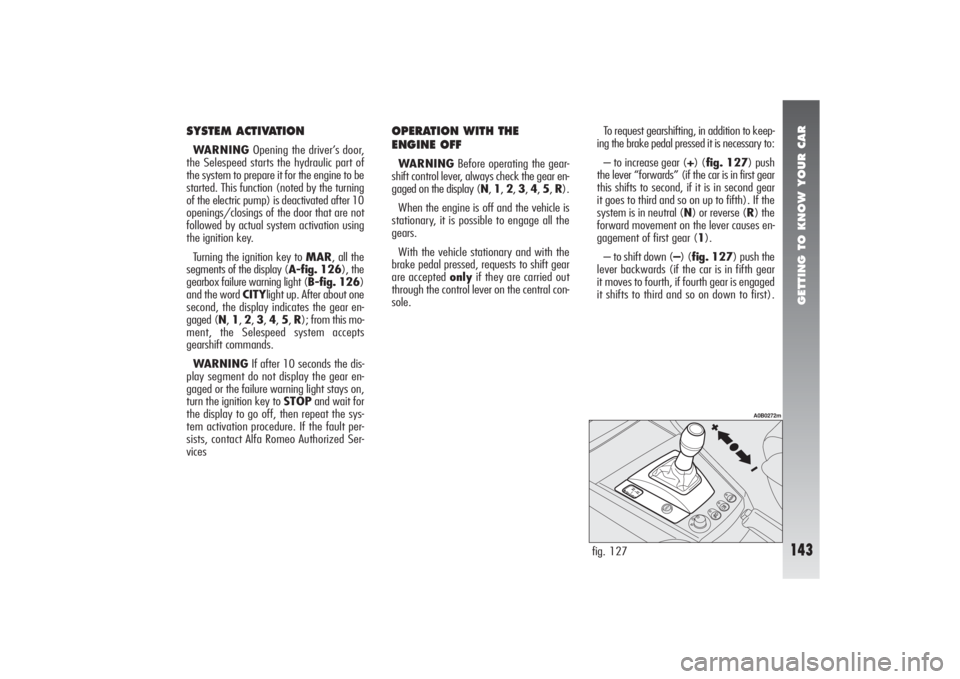
GETTING TO KNOW YOUR CAR
143
SYSTEM ACTIVATIONWARNINGOpening the driver’s door,
the Selespeed starts the hydraulic part of
the system to prepare it for the engine to be
started. This function (noted by the turning
of the electric pump) is deactivated after 10
openings/closings of the door that are not
followed by actual system activation using
the ignition key.
Turning the ignition key to MAR, all the
segments of the display (A-fig. 126), the
gearbox failure warning light (B-fig. 126)
and the word CITYlight up. After about one
second, the display indicates the gear en-
gaged (N, 1, 2, 3, 4, 5, R); from this mo-
ment, the Selespeed system accepts
gearshift commands.
WARNINGIf after 10 seconds the dis-
play segment do not display the gear en-
gaged or the failure warning light stays on,
turn the ignition key to STOPand wait for
the display to go off, then repeat the sys-
tem activation procedure. If the fault per-
sists, contact Alfa Romeo Authorized Ser-
vices
OPERATION WITH THE
ENGINE OFFWARNINGBefore operating the gear-
shift control lever, always check the gear en-
gaged on the display (N, 1, 2, 3, 4, 5, R).
When the engine is off and the vehicle is
stationary, it is possible to engage all the
gears.
With the vehicle stationary and with the
brake pedal pressed, requests to shift gear
are accepted onlyif they are carried out
through the control lever on the central con-
sole.To request gearshifting, in addition to keep-
ing the brake pedal pressed it is necessary to:
– to increase gear (+) (fig. 127) push
the lever “forwards” (if the car is in first gear
this shifts to second, if it is in second gear
it goes to third and so on up to fifth). If the
system is in neutral (N) or reverse (R) the
forward movement on the lever causes en-
gagement of first gear (1).
– to shift down (–) (fig. 127) push the
lever backwards (if the car is in fifth gear
it moves to fourth, if fourth gear is engaged
it shifts to third and so on down to first).
fig. 127
A0B0272m
Page 147 of 357
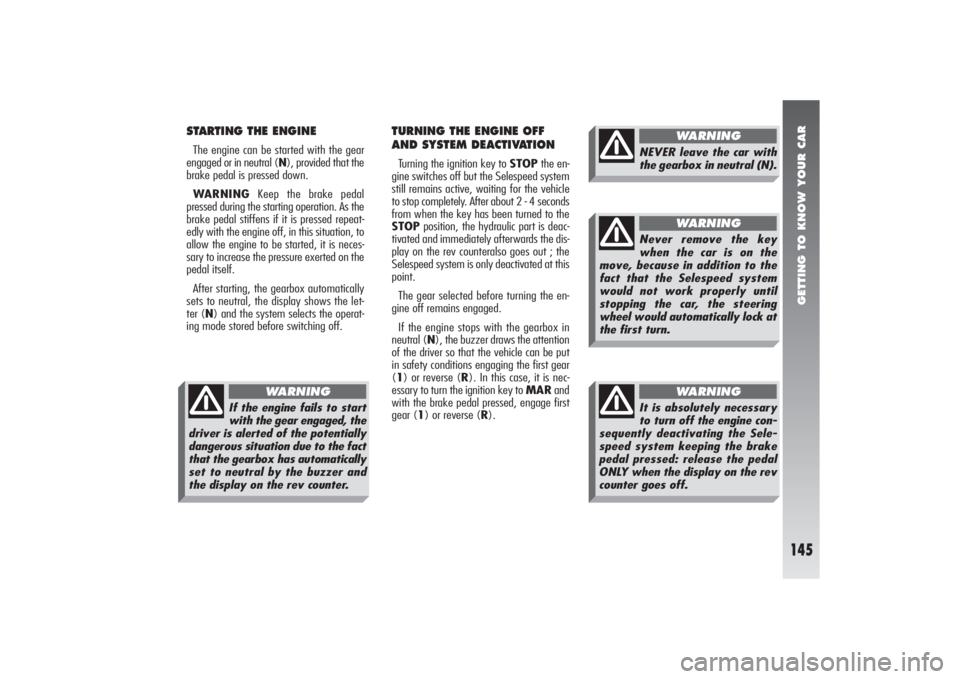
GETTING TO KNOW YOUR CAR
145
STARTING THE ENGINEThe engine can be started with the gear
engaged or in neutral (N), provided that the
brake pedal is pressed down.
WARNINGKeep the brake pedal
pressed during the starting operation. As the
brake pedal stiffens if it is pressed repeat-
edly with the engine off, in this situation, to
allow the engine to be started, it is neces-
sary to increase the pressure exerted on the
pedal itself.
After starting, the gearbox automatically
sets to neutral, the display shows the let-
ter (N) and the system selects the operat-
ing mode stored before switching off.
TURNING THE ENGINE OFF
AND SYSTEM DEACTIVATIONTurning the ignition key to STOPthe en-
gine switches off but the Selespeed system
still remains active, waiting for the vehicle
to stop completely. After about 2 - 4 seconds
from when the key has been turned to the
STOPposition, the hydraulic part is deac-
tivated and immediately afterwards the dis-
play on the rev counteralso goes out ; the
Selespeed system is only deactivated at this
point.
The gear selected before turning the en-
gine off remains engaged.
If the engine stops with the gearbox in
neutral (N), the buzzer draws the attention
of the driver so that the vehicle can be put
in safety conditions engaging the first gear
(1) or reverse (R). In this case, it is nec-
essary to turn the ignition key to MARand
with the brake pedal pressed, engage first
gear (1) or reverse (R).
If the engine fails to start
with the gear engaged, the
driver is alerted of the potentially
dangerous situation due to the fact
that the gearbox has automatically
set to neutral by the buzzer and
the display on the rev counter.
WARNING
NEVER leave the car with
the gearbox in neutral (N).
WARNING
Never remove the key
when the car is on the
move, because in addition to the
fact that the Selespeed system
would not work properly until
stopping the car, the steering
wheel would automatically lock at
the first turn.
WARNING
It is absolutely necessary
to turn off the engine con-
sequently deactivating the Sele-
speed system keeping the brake
pedal pressed: release the pedal
ONLY when the display on the rev
counter goes off.
WARNING
Page 148 of 357
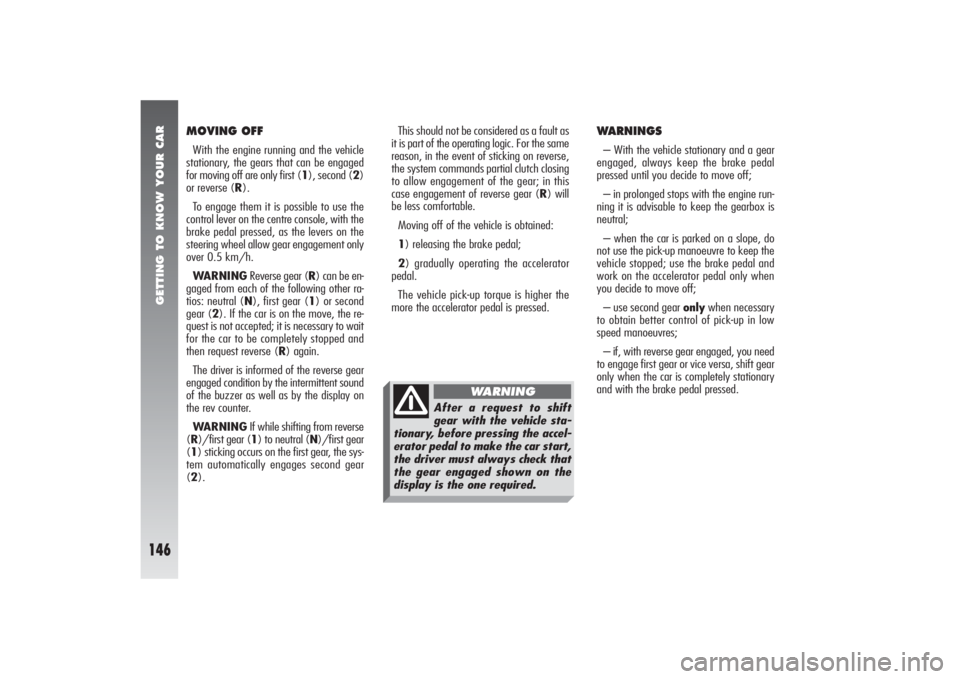
GETTING TO KNOW YOUR CAR
146
WARNINGS– With the vehicle stationary and a gear
engaged, always keep the brake pedal
pressed until you decide to move off;
– in prolonged stops with the engine run-
ning it is advisable to keep the gearbox is
neutral;
– when the car is parked on a slope, do
not use the pick-up manoeuvre to keep the
vehicle stopped; use the brake pedal and
work on the accelerator pedal only when
you decide to move off;
– use second gear onlywhen necessary
to obtain better control of pick-up in low
speed manoeuvres;
– if, with reverse gear engaged, you need
to engage first gear or vice versa, shift gear
only when the car is completely stationary
and with the brake pedal pressed. This should not be considered as a fault as
it is part of the operating logic. For the same
reason, in the event of sticking on reverse,
the system commands partial clutch closing
to allow engagement of the gear; in this
case engagement of reverse gear (R) will
be less comfortable.
Moving off of the vehicle is obtained:
1) releasing the brake pedal;
2) gradually operating the accelerator
pedal.
The vehicle pick-up torque is higher the
more the accelerator pedal is pressed.
MOVING OFFWith the engine running and the vehicle
stationary, the gears that can be engaged
for moving off are only first (1), second (2)
or reverse (R).
To engage them it is possible to use the
control lever on the centre console, with the
brake pedal pressed, as the levers on the
steering wheel allow gear engagement only
over 0.5 km/h.
WARNINGReverse gear (R) can be en-
gaged from each of the following other ra-
tios: neutral (N), first gear (1) or second
gear (2). If the car is on the move, the re-
quest is not accepted; it is necessary to wait
for the car to be completely stopped and
then request reverse (R) again.
The driver is informed of the reverse gear
engaged condition by the intermittent sound
of the buzzer as well as by the display on
the rev counter.
WARNINGIf while shifting from reverse
(R)/first gear (1) to neutral (N)/first gear
(1) sticking occurs on the first gear, the sys-
tem automatically engages second gear
(2).
After a request to shift
gear with the vehicle sta-
tionary, before pressing the accel-
erator pedal to make the car start,
the driver must always check that
the gear engaged shown on the
display is the one required.
WARNING
Page 149 of 357

GETTING TO KNOW YOUR CAR
147
STOPPING THE CARTo stop the vehicle, simply release the ac-
celerator pedal and, if necessary, operate
the brake pedal.
Regardless of the gear engaged and of the
operating mode activated (MANUALor
CITY), the system automatically disen-
gages the clutch and downshifts gear.
If you intend to move off again without
having completely stopped the car, this way
the most suitable gear ratio for re-acceler-
ating will be available.
Stopping the vehicle, the system auto-
matically engages first gear (1). Though strongly inadvisable, if due to un-
foreseen circumstances when driving down-
hill the car is allowed to travel with the gear-
box in neutral (N), when the engagement
of a gear is requested, the system auto-
matically engages the best gear to allow
transmission of the torque to the wheels in
relation to the speed of the car.
Downhill with the gear engaged and the
accelerator released (if the vehicle is trav-
elling), if a certain pre-established speed is
exceeded, the system automatically en-
gages the clutch to provide adequate engine
braking.
Due to safety reasons, the Selespeed sys-
tem activates the buzzer when:
– clutch overheating occurs during vehicle
starting; in this case, it is necessary to
“force” moving off avoiding hesitations or
to release the accelerator and use the brake
pedal to park the vehicle if the car is on a
slope;
– the car moves in the opposite direction
to the gear engaged, (e.g.: vehicle moving
forward with reverse engaged); in this sit-
uation it is necessary to stop the vehicle and
keeping the brake pedal pressed, engage
the gear correctly.Still for safety reasons, when the vehicle
is stationary, with the engine started and
gear (1), (2) or (R) engaged, the system
activates the buzzer and shifts to neutral
(N) automatically when:
– there is no action on the accelerator
and/or brake pedal for at least 3 minutes;
– the brake pedal is pressed for over 10
minutes;
– the driver’s door is opened and the ac-
celerator and brake pedal are not pressed
for at least 1 second.
Page 151 of 357

GETTING TO KNOW YOUR CAR
149
When shifting gear, releasing the acceler-
ator pedal is not necessary because the Se-
lespeed system directly controls the engine
so as to:
– reduce and then increase the engine
torque;
– adapt the engine speed to the new gear
ratio engaged.
When downshifting, double de-clutching
(acceleration of the engine to bring it to the
speed necessary with the new gear ratio) is
carried out automatically.
The move to neutral (N) command is ac-
cepted when the car speed exceeds 20 km/h.
The command to engage reverse gear (R)
is accepted only if the car is stationary.With the accelerator pedal pressed by over
60% of its stroke and with an engine speed
of over 5,000 rpm, gearshifting becomes
quicker.
In the MANUALmode there are some
automatic/safety devices which make dri-
ving easier:
– when slowing down, the clutch is
opened and the gear ratio is reduced auto-
matically to be ready for possibly picking up
speed again; if not, stopping the vehicle,
first gear (1) will be engaged automatically;
– request to change gear that could take
the engine above the maximum rpm or be-
low the minimum permissible rpm are not
accepted;– if the engine reaches the maximum per-
missible rpm and accelerating continues
(without coming into operation of the VDC
system), the system automatically engages
a higher gear; with the activation of the VDC
system, with the maximum engine rpm,
gear shifting is excluded;
– if sticking occurs during the engagement
of a gear, the system firstly tries to engage
the required gear again and, if it is still not
possible, it automatically engages the im-
mediately higher one to avoid leaving the
vehicle in neutral speed.
WARNINGIt is advisable to wait for a
gearshift to end before requesting another
one, this will avoid multiple requests in quick
succession.
Page 152 of 357
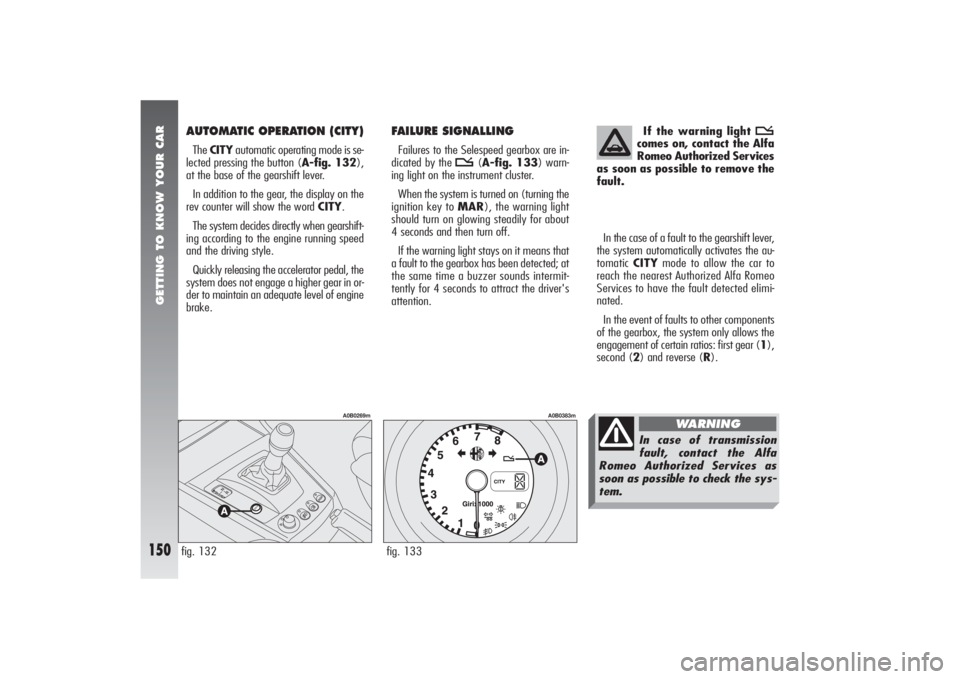
GETTING TO KNOW YOUR CAR
150
AUTOMATIC OPERATION (CITY)The CITYautomatic operating mode is se-
lected pressing the button (A-fig. 132),
at the base of the gearshift lever.
In addition to the gear, the display on the
rev counter will show the word CITY.
The system decides directly when gearshift-
ing according to the engine running speed
and the driving style.
Quickly releasing the accelerator pedal, the
system does not engage a higher gear in or-
der to maintain an adequate level of engine
brake.
FAILURE SIGNALLINGFailures to the Selespeed gearbox are in-
dicated by the
t
(A-fig. 133) warn-
ing light on the instrument cluster.
When the system is turned on (turning the
ignition key to MAR), the warning light
should turn on glowing steadily for about
4 seconds and then turn off.
If the warning light stays on it means that
a fault to the gearbox has been detected; at
the same time a buzzer sounds intermit-
tently for 4 seconds to attract the driver's
attention.In the case of a fault to the gearshift lever,
the system automatically activates the au-
tomatic CITYmode to allow the car to
reach the nearest Authorized Alfa Romeo
Services to have the fault detected elimi-
nated.
In the event of faults to other components
of the gearbox, the system only allows the
engagement of certain ratios: first gear (1),
second (2) and reverse (R).
fig. 132
A0B0269m
fig. 133
A0B0383m
If the warning light
t
comes on, contact the Alfa
Romeo Authorized Services
as soon as possible to remove the
fault.In case of transmission
fault, contact the Alfa
Romeo Authorized Services as
soon as possible to check the sys-
tem.
WARNING